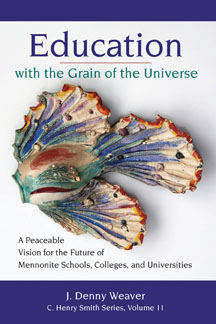|
|
A wise professor once told me: “It is more important to ask hard questions than to provide easy answers.” This collection of essays—first presented at an academic interdisciplinary conference at Bluffton University and supported by the C. Henry Smith Trust Fund—is committed to enunciating a “peaceable vision for the future of our Mennonite schools.” Wisely, it resists pat answers—as enticing as that might have been for each of these astute scholars. Taken together, these thoughtful, provocative essays, carefully edited by J. Denny Weaver, are an anthem to the pedagogical model of asking hard questions, of stimulating inquiry and invitation and furthering the conversation on important educational questions of our time, including these: How is Jesus relevant in our schools? What meaningful peace witness can Mennonite education provide? I think readers will be most impressed by the tough questions, peculiar perspective, and aspirational sights that this volume of scholarship knits together. The collection is tailored to help lively interdisciplinary discussions in our Anabaptist educational institutions and our congregations. The take-aways are fulsome (encourage big gulps), imperative (demand attention), and challenging (are we ready for this?). Tough Questions (in the spirit of humility)In the spirit of humility, these scholars ask readers to contemplate difficult questions, such as: Why do Mennonites, known for brokering peace around the world, have such trouble making peace with themselves? Is it more important for Mennonites to be born into the right family (white, German heritage) than to walk in the footsteps of Jesus? Why do Mennonite scholars choose dialogue partners that look and think like them? How can we take sustenance from our traditional storyline while at the same time allow new flavors to change our “saltiness?” Perhaps the most perplexing question for Mennonite
scholars is this
one: Why in 2017 are we still having to explain what a Mennonite is and
what we believe even to other scholars? There are other more pointed
questions related to biblical interpretation (What do we do with all
the divine violence in the Old Testament?), organizational dynamics
(Why do Mennonites have a tendency to misappropriate servant
leadership?), and Anabaptist history (Our Anabaptist forebears used the
Apocrypha and Scripture with no distinction. Why don’t we do that
today?). Peculiar Perspectives (from the margins)In
the spirit of nonconformity, many of these authors unpack the tension,
dare I say the oxymoronic pairing, between “Mennonite” (“priesthood of
all believers”) and “theology” (foundational, systematic authority).
Mennonites are more about “orthopraxy” (actual lifestyle) than
orthodoxy (rigid belief system),” but this peculiar clash is celebrated
here. A palpable nonconformist “big tent” perspective is embraced by
the authors even as Anabaptist essentials are articulated. On other topics irony
also reigns supreme, such as the observation that “students should go
to church to discover how truly flawed and disastrous the church
actually is.” The rationale offered is that if we expose students to
the difficulty of our church history, they actually will be more
“energized,” than “scandalized” by the failures of the church! Now
that’s turning convention on its head! Aspirational Sights (as followers of Jesus)In the spirit of Isaiah 54:2, these essays “enlarge the place of our tents, stretch our curtain wide. They do not hold back; they lengthen our cords as they strengthen our stakes.” They welcome all (stretch the curtains) and affirm Anabaptist values of peace and discipleship (strengthening stakes). They conclude that church should be a “safe harbor” and “adventure.” That we should not get hung up on distracting issues (creationism versus evolution; God or science). We should hold these views together with integrity. That we should not see the Sermon on the Mount (“turn the other cheek”) as some passive “do-nothing” stance but as a “take-charge” modeling of active nonviolence. That this country stands in need of a peace witness that Mennonite education can provide as it tells Jesus’ story as one that is principally a rejection of the sword. As I was traveling recently
through what some might call the heart of “Mennonite country”
(Lancaster, Pa.), I saw a barn with a handcrafted sign: “Know Jesus.
Know Peace.” I smiled. Simple, Profound. Aspirational. In the oral mode
it invites us to see from an ironic, peculiar angle: “No Jesus. No
Peace.” As an interrogative, the sign challenges us to confront: “Do
you really know Jesus? Know Peace? The scholars in this collection of
essays wrestle earnestly and even eloquently with the words of this
sign. |
|||||





